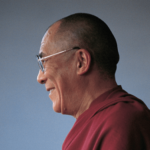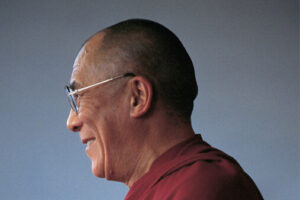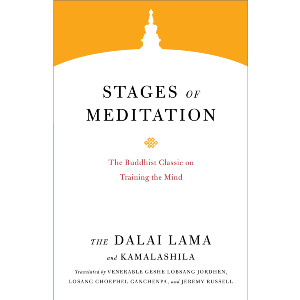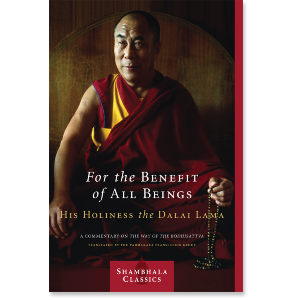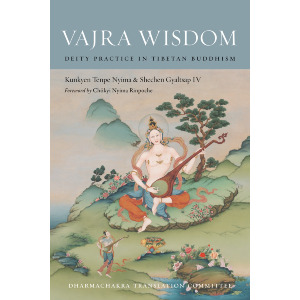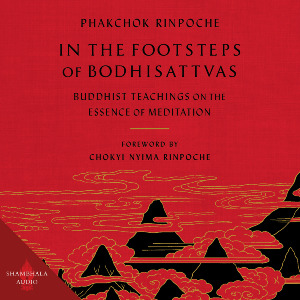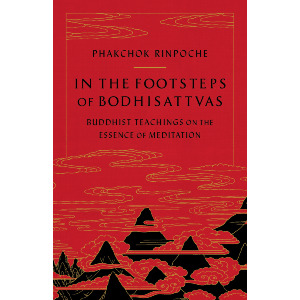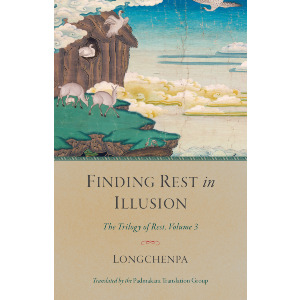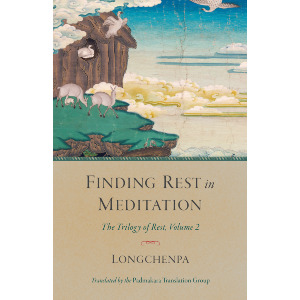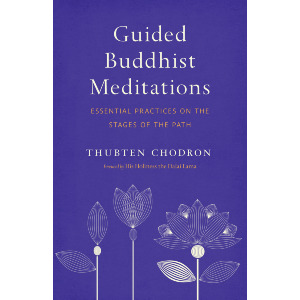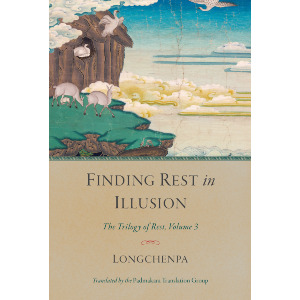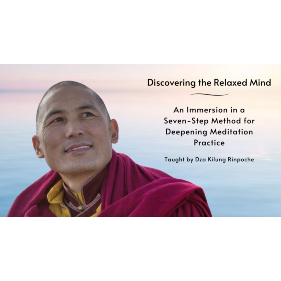| The following article is from the Summer, 2003 issue of the Snow Lion Newsletter and is for historical reference only. You can see this in context of the original newsletter here. |
This extensive explanation of the hows and whys of meditation is a commentary on a classic meditation handbook by Kamalashila, which the Dalai Lama calls a key that opens the door to all other major Buddhist scriptures. Practice-oriented Westerners will find this warmly presented, lucid book especially useful.
When meditating, the yogi should first complete all the preparatory practices. He should go to the toilet and in a pleasant location free of disturbing noise he should think, "I will deliver all sentient beings to the state of enlightenment." Then he should manifest great compassion, the thought wishing to liberate all sentient beings, and pay homage to all the Buddhas and Bodhisattvas in the ten directions by touching the five limbs of his body to the ground.
Invoke a merit-field by visualizing Buddhas and Bodhisattvas in the space in front of you and make prayers. This is an exclusively sutric practice. When the invocation is done in relation to tantra, you generate the commitment being and merge the wisdom being with it.
When you make prostrations, tradition recommends that you do so by touching your five limbs—your forehead, two palms, and two knees—to the ground. The important thing is that it should be done properly and with delight. It is unwholesome to perform prostrations either as a mere formality or under coercion.
Representations of the Buddha's Body, Speech, and Mind can be arranged physically on an altar or can be visualized in the space in front of you. Offerings should be made according to your means. If you are fortunate and wealthy, well and good. But if you do not have the means to obtain many images of the Buddha, there is no need to acquire them improperly. Statues and thangkas acquired by fraud and deceit, instead of bringing virtue, bring only negative consequences.
If you are a solitary monk in retreat in the mountains, too many religious images will only tempt thieves to no great purpose. In the past, great saints like Milarepa possessed high realizations but no such images. Milarepa lived in an empty cave. There is a story that one night a thief entered his cave, searching for something to steal. Mila laughed and asked him, "What are you looking for? When I cannot find anything in the daytime, what do you expect to find at night?" Thus, we should remember that spiritual realizations are developed within, and that external objects are not of much consequence.
There are people who in the name of religious practice struggle hard to erect an elaborate and costly altar. Loaded with images it becomes part of their household furniture and ceases to be of much significance or purpose. So, if you can obtain representations of the Buddha's Body, Speech, and Mind in an acceptable manner, you should have a statue of Shakyamuni Buddha, the founder of Buddhism. To represent Iris speech, you can set up a copy of the Perfection of Wisdom Sutra as the main text together with a copy of the Avatamsaka Sutra, which deals with the deeds of Bodhisattvas. Next to them you can place those things which represent the mind of the Buddhas.
...manifest great compassion, the thought wishing to liberate all sentient beings, and pay homage to all the Buddhas and Bodhisattvas in the ten directions....
If you cannot obtain these things, don't worry about it. But if you can, they should be arranged in a proper way. In the center should be a painting, statue, or similar image of Buddha Shakyamuni. Around him should be representations of meditational deities in both peaceful and wrathful aspects, and representations of the Buddha's eight great immediate disciples. If, on the other hand, these images are arranged according to their monetary value, the quality of the material from which they are made, or whether they are new or antique, then you are making a serious mistake. To do so would reveal that you viewed these holy images as nothing more than material possessions.
So, with understanding of its meaning and purpose, arrange your altar in the proper order. Make prostrations and arrange offerings before the holy objects. You should be careful about what you offer. If you offer what are called pure materials, you can accumulate immense virtue. Conversely, if the materials are impure, then instead of gaining virtue you are liable to face negative consequences. Impure materials refers to things acquired by the five wrong livelihoods, such as flattery, deceit, and so forth. This is of particular concern for ordained people.
When people treat scriptures and statues or photos of Buddhas as commercial items and do business with them for personal gain, it is wrong livelihood. It is certainly unwholesome and has serious negative consequences. On the other hand, when people work to publish scriptural texts, make statues, and so forth, in order to propagate the Buddha's doctrine, it is a different matter. In such cases, when individuals are motivated to help those in need of such religious support, they are engaged in wholesome activities. We must, therefore, realize the importance of offering pure materials. There is a widespread tradition among Tibetans of offering bowls of water and butter lamps. This, too, should be done respectfully and in a proper manner.
To read more about Tibetan altars, click here.
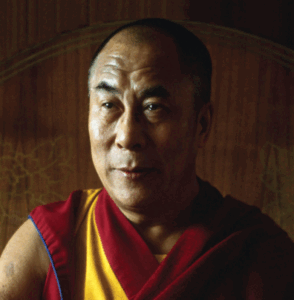
His Holiness the Fourteenth Dalai Lama is considered the foremost Buddhist leader of our time. The exiled spiritual head of the Tibetan people, he is a Nobel Peace Laureate, a Congressional Gold Medal recipient, and a remarkable teacher and scholar who has authored over one hundred books.
Related Books
$19.95 - Paperback
$21.95 - Paperback
Kindness, Clarity, and Insight
$16.95 - Paperback

